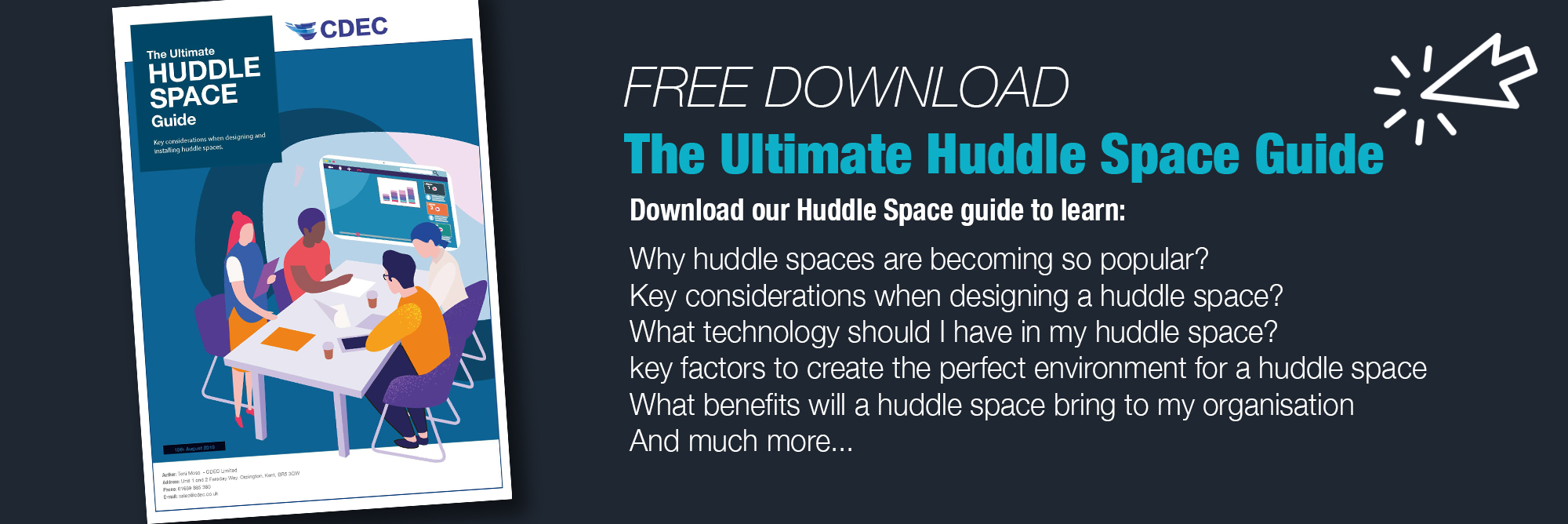The most accepted definition of a huddle space is a small, private and comfortable meeting area designed to accommodate 2-6 people and equipped with teleconferencing and collaborative tools. Their size and the technologies typically housed within them makes huddle rooms ideal for both scheduled and impromptu meetings, offering a quieter space for people to work without having to reserve time in a large meeting space or boardroom.
Download our ultimate huddle space guide here.
Key Huddle Space Considerations
There are a number of key factors that need to be considered in order to create a huddle room that is comfortable and fit for purpose. The top four areas to bear in mind are:
1. Acoustics
An often-overlooked aspect in many areas of corporate AV, investing in acoustics can make a huge difference to the user experience, and to other employees. Remember that huddle rooms are designed to enhance communication, whether between internal employees or with remote workers and other external stakeholders. Overlooking acoustics could make this nigh on impossible.
Acoustics are as important when having a catch up with your team as they are when on a videoconference. Sound insulation can be a good starting point, preventing noise leakage into and out of the room; in addition, the right microphone and speaker system will ensure everyone in the room can be heard comfortably – even by those at the far end of a video call.
The good news is that audio systems have become much more intelligent in recent years and many are now able to distinguish between the human voice and ambient noise. In addition, although office design often tends towards hard, reflective surfaces such as glass and tiles, there are a number of easy ways to reduce ambient noise, from introducing rugs and curtains to acoustic dampening panels.
2. Lighting
Put simply, if the lighting isn’t right in your huddle room, productivity will be affected. Too much sunlight can also make it difficult to be seen clearly on a video call as well as proving a distraction for those trying to work. On the other hand, if spaces are too dark it is difficult to work effectively.
As huddle rooms are inherently flexible spaces which can be used for a multitude of different tasks, it’s important to choose a lighting solution that creates the desired atmosphere. Ceiling lighting and central lighting should solve most problems, but also consider the need for spotlights. LEDs can offer reduced power consumption, while human-centric lighting can offer customised light that ensures optimum working conditions and improved employee wellbeing.
Always try to make the most of natural light in huddle rooms – although shading should be provided to give the user control over their environment. You could also consider installing a lighting control system for the optimum user experience.
3. Furniture
This can often be a last-minute consideration when designing a huddle room and in many cases, the final result is let down by the addition of cheap, uncomfortable and flimsy furniture. Remember, huddle spaces are built for collaboration and the right furniture can enhance this.
From desks that have integrated displays that make it easier for all participants to view content, to height adjustable desks that add even more flexibility to workspaces, the right furniture can make or break a room. Whatever your preferred style, make sure there is enough desk space for each participant to be able to bring their own devices and work comfortably – a cramped space will not be popular with users.
4. Connectivity
There’s no point in investing in the best audio and video if connectivity hasn’t been considered, whether that’s ease of connecting to calls, WiFi that works as well in the room as it does in the main workspace, or simply ensuring that there are enough ports for devices to be charging when in use. Nobody wants to be worrying about their laptop dying halfway through a presentation, so make these points easily accessible – they can even be built into furniture for added ease.
The secret to ensuring high user uptake of huddle rooms is to create a space that people want to use and that actually makes their job easier. Technology is central to this, but taking a holisitic approach that also covers environment and comfort will help to create the ultimate huddle room for your business.

